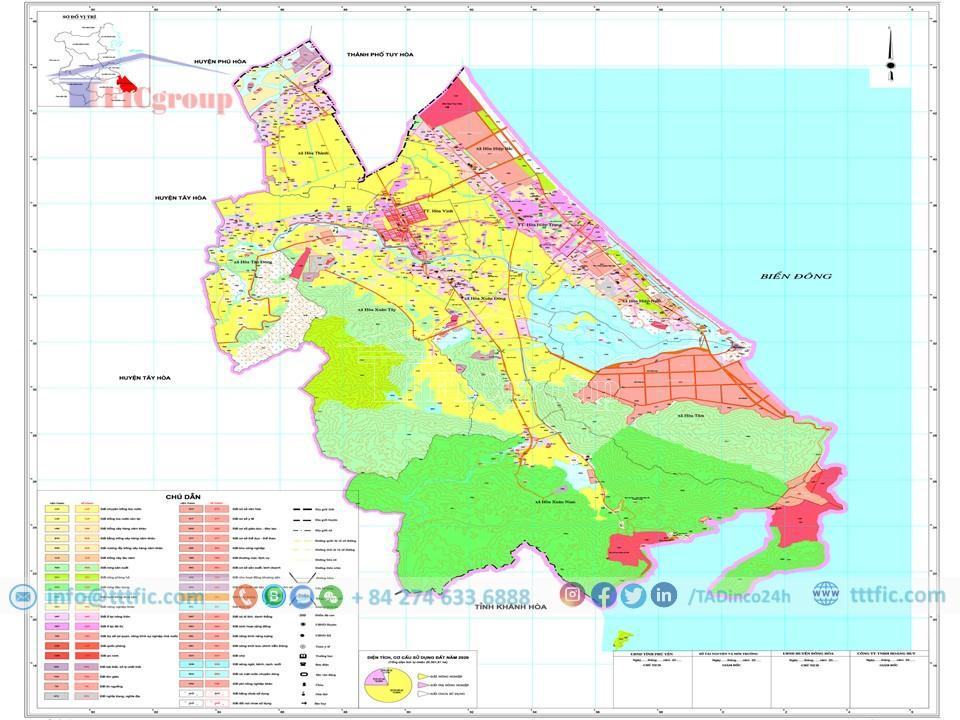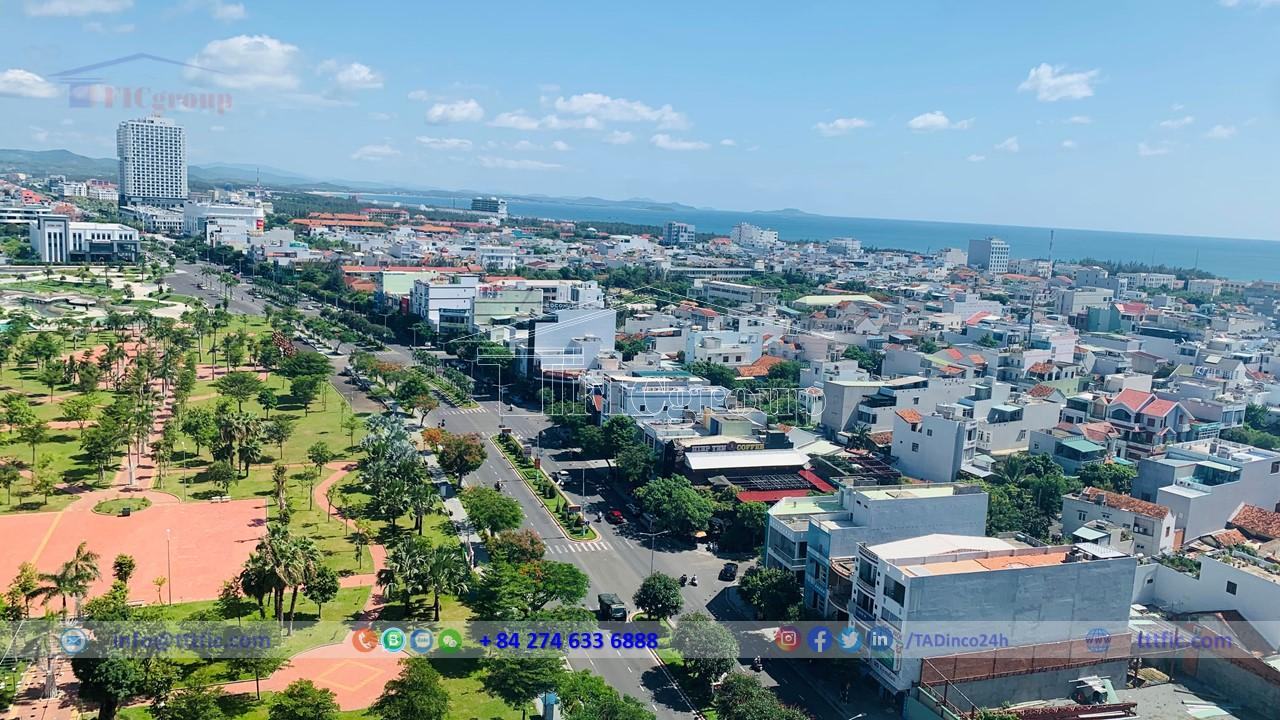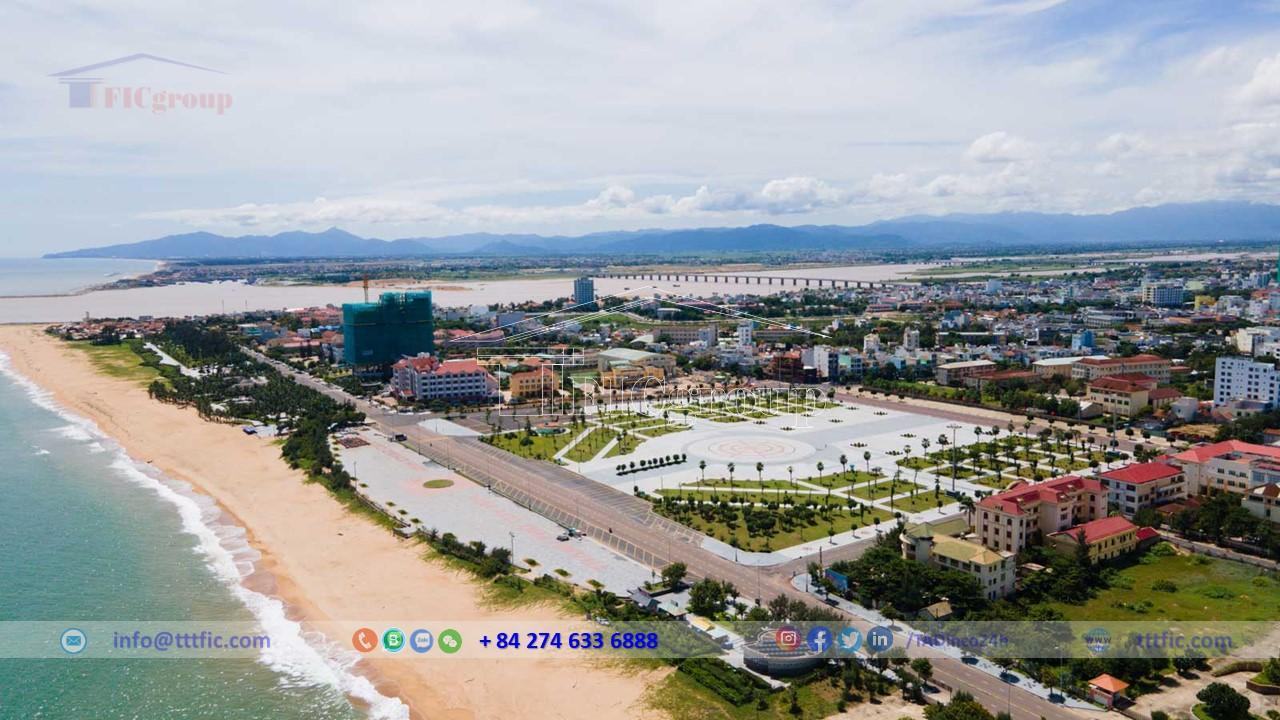
NORTH-EAST SONG CAU 2 INDUSTRIAL PARK
- Investor: Management Board of Industrial Parks of Phu Yen Province
- Price: 30 USD/m2
- Area: 81.8 Ha
Phu Yen province, a coastal province in the northern part of Vietnam’s South Central Coast region, has the following characteristics. In 2018, it ranked 45th in population, 43rd in Gross Regional Domestic Product (GRDP), 30th in per capita GRDP, and 25th in GRDP growth rate among Vietnamese administrative units. With a population of 961.1 thousand, its GRDP reached 36,352 billion Dong (equivalent to 1.579 billion USD), per capita GRDP stood at 39.97 million Dong (equivalent to 1,736 USD), and the GRDP growth rate reached 8.3%.
Situated between the Cù Mông Pass to the north and the Cả Pass to the south, Phu Yen lies within the Duyên Hải Nam Trung Bộ region. The province benefits from a convenient transportation system, with National Highway 1 and the North-South Railway passing through it. National Highway 25 connects it to the majestic Central Highlands, while National Highway 29 links the international seaport of Vung Ro to the Dak-Rue border gate in Dak Lak. Tuy Hoa Airport is capable of accommodating large aircraft such as the A321 and Boeing 747. Currently, it operates routes between Tuy Hoa and Ho Chi Minh City, as well as Tuy Hoa and Hanoi.
Covering a natural area of 5,060 km2, Phu Yen is characterized by hills and mountains, which occupy 70% of its territory. The terrain slopes from west to east and is heavily dissected. It shares borders with Binh Dinh to the north, Khanh Hoa to the south, Gia Lai and Dak Lak to the west, and the East Sea to the east. The province’s favorable geographical location and transportation infrastructure contribute to its socio-economic development.

Phu Yen Province – Vietnam – TTTFIC Group
Phu Yen extends from 12°42’36” to 13°41’28” latitude North and from 108°40’40” to 109°27’47” longitude East. It shares borders with Binh Dinh to the north, Khanh Hoa to the south, Dak Lak and Gia Lai to the west, and the East Sea to the east. Phu Yen’s geographical location and transportation infrastructure are relatively favorable for socio-economic development.
Located in Central Vietnam, the provincial capital of Phu Yen is the city of Tuy Hoa. It is 1,160 km north of the capital Hanoi, 560 km south of Ho Chi Minh City, and 438 km north of Da Nang via National Highway 1.
The province has a natural area of 5,045 km², with a coastline stretching 189 km.

Administrative map of Phu Yen Province – TTTFIC Group
Phu Yen’s terrain comprises three aspects: mountains to the north (Cù Mông Pass), mountains to the south (Cả Pass), the eastern coast of the Truong Son Range, and the East Sea to the east.
Known for its Tuy Hoa plain, Phu Yen is considered the “rice granary” of the Central region.
The province has a tropical monsoon climate, hot and humid, influenced by the oceanic climate. It experiences two distinct seasons: the rainy season from September to December and the dry season from January to August. The average annual temperature is 26.5 °C, with an average annual rainfall of about 1,600 – 1,700mm.
Phu Yen is home to the Da Rang River system, the Ban Thach River, and the Ky Lo River, covering a total basin area of 16,400 km² and a total flow volume of 11.8 billion m3. This ensures sufficient water supply for agriculture, hydropower, and daily activities.
The province also boasts several hot mineral springs, such as Phu Sen, Triem Duc, Tra O, and Lac Sanh. Additionally, there are abundant mineral resources underground, including 90 million m3 of diatomite, 54 million m3 of multi-colored granite, and 300,000 tons of placer gold (data from 2006 according to the Phu Yen Tourism and Trade Promotion Handbook).
Phu Yen’s land resources are diverse and distributed across various terrains, creating suitable agricultural and forestry ecosystems for different types of crops, especially perennial crops in hilly areas. There are eight main soil groups: Yellow-Red Soil, the largest group, covering 336,579 hectares (66.71%); Coastal Sand Soil, covering 15,009 hectares (2.97%); Saline and Alkaline Soil, covering 7,899 hectares (1.57%); Alluvial Soil, covering 55,752 hectares (11.05%); Gray Soil, covering 39,552 hectares (7.84%); Black Soil, covering 18,831 hectares (3.73%); Red-Yellow Soil on Mountains, covering 11,300 hectares (2.5%); Sloping Valley Soil, covering 1,246 hectares; and Other Soil Types, covering 21,192 hectares (4.21%).
Phu Yen possesses a well-distributed river system throughout the province. These rivers originate from the eastern side of the Truong Son Range, flow through hilly and mountainous terrain in the middle and upper reaches, and then empty into the narrow coastal plain before reaching the sea. Phu Yen boasts over 50 major and minor rivers, with three notable ones: Ky Lo River, Ba River, and Ban Thach River. The total basin area of these rivers is 16,400 km², with a total flow volume of 11.8 billion m³, serving agricultural irrigation, hydropower, and the daily needs of the local population.
Surface water sources:
The majority of the river and stream networks in Phu Yen originate from the Truong Son Range in the west, Cù Mông Range in the north, and Cả Pass in the south. These rivers and streams are relatively short and steep, resulting in fast-flowing currents. The Ba River has the largest water storage capacity in the province, with an annual water discharge of 9.7 billion m³. The Ban Thach River has a total flow volume of 0.8 billion m³ per year. The Ky Lo River is the second-largest river in the province, with a basin area of 1,950 km², of which 1,560 km² is within the province.
Groundwater sources:
The natural exploitable groundwater potential in the province is approximately 1,202.7 x 106 m³ per day.
Mineral water:
Phu Yen is rich in mineral water resources, with four hot mineral water locations in Son Thanh (Tay Hoa district), Phuoc Long in Xuan Long commune, Triem Duc (Dong Xuan district), and Phu Sen (Phu Hoa district).
With a coastline stretching 189 km, featuring numerous bays, beaches, lagoons, and estuaries, Phu Yen offers pristine and diverse ecological landscapes, making it a great potential for coastal tourism, resorts, and ecotourism. Additionally, Phu Yen’s extensive tidal flats, river mouths, lagoons, and bays provide favorable conditions for the development of aquaculture and seafood export. These resources and advantages contribute to Phu Yen’s potential for coastal economic development.
Phu Yen is rich in forest resources, particularly in Son Hoa district, which has tens of thousands of hectares of forests. These forests harbor valuable timber species such as Bằng Lăng, Chang gà, Côn, Ba thưa, Chò, Gõ, Sơn, Kiền kiền, Lim, Trắc, as well as various wildlife including bears, deer, monkeys, bison, civets, foxes, rabbits, and porcupines. The district is also a hub for developing industrial crops like coffee, cashews, and tobacco, along with a variety of fruit trees such as durian, jackfruit, banana, orange, and pomelo.
The province has three main types of forests. The evergreen broad-leaved forests are the most common, covering 96.5% of the province’s natural forest area. The deciduous forests, accounting for 3.5% of the natural forest area, shed their leaves seasonally. The planted forests cover an area of 20,963.0 hectares, with approximately 8.4 million scattered trees (equivalent to 4,200 hectares). The main tree species include keo tai tượng, xà cừ, phi lao, cashew, dầu rái, sao đen, gõ đỏ, muồng đen, giáng hương, and others. Phu Yen’s forest ecosystem is home to diverse flora and fauna, with 43 bird families comprising 114 species (including 7 rare species), 20 mammal families with 51 species (including 21 rare species), and 3 reptile families with 22 species (including 2 rare species).
Phu Yen is also abundant in mineral resources, including colored granite, diatomite, bauxite, fluorite, mineral water, lignite, and placer gold.

Tuy Hoa City – Phu Yen Province – Vietnam – TTTFIC Group
The economic situation for the first 9 months of 2022:
Annual crop areas reached 128,662 thousand hectares, a 0.6% increase. Cassava and sugarcane saw slight growth, while grain and various vegetables declined. The winter-spring rice yield dropped 15.9%, decreasing the overall grain yield by 7.3%. Although summer-autumn rice yield is higher, the falling domestic market price amidst increasing supply costs negatively impacts farmer income. Sugarcane yield significantly increased due to enhanced care and expanded planting areas.
Livestock and poultry populations remained stable, adequately supplying local food needs. However, higher feed prices limited herd expansion. Disease control effectively prevented severe livestock and poultry diseases, and farming moved towards centralized, industrialized methods, ensuring disease safety. Currently, there are 160 livestock farms.

Phu Yen Province – Vietnam – TTTFIC Group
Phu Yen’s population of 874,071 (2020) is largely rural, with urban residents making up 28.7%. The labor force accounts for 71.5% of the population.
Nearly 30 ethnic groups coexist in Phu Yen. Cham, Êđê, Ba Na, Hrê, Hoa, Raglai are long-standing residents.
After the liberation of the South, new migrants from the northern mountains such as Tày, Nùng, Dao, Sán Dìu, settled in Song Hinh.
As of April 1, 2019, the province is home to 9 religions with 67,594 followers, led by Catholicism (35,206 people), followed by Buddhism (27,290 people), Protestantism (2,928 people), Cao Dai (2,006 people), Hoa Hao Buddhism (113 people). Other religions include Islam (20 people), Brahmanism (13 people), Tinh Do Buddhist Association (10 people), and Baha’i.
In 2022, labor, invalids and social affairs saw significant progress. New jobs were created for 19,500 workers, achieving 78% of the plan. This includes 3,500 fresh positions (52.89% of the plan), and 350 people were sent abroad for work.
There are 465,965 people aged 15 and above employed, accounting for 53.2% of the province’s population, a 9% increase. Unemployment rates fell as business activities gradually recovered. Social insurance coverage reached an estimated 15.8%. Unemployment insurance policies were fully implemented, providing rental assistance to 205 workers, totaling 319 million VND.
Vocational training efforts increased. Vocational education institutions offered diverse courses, training a total of 6,470 people, achieving 80.87% of the plan.
Full, timely support was provided to policy beneficiaries and social subjects, especially during holidays. A total of 99,089 health insurance cards were issued to the poor and near-poor households and residents living in extremely disadvantaged areas. Electricity cost support was provided to 12,941 poor households. Development loans worth 462.687 billion VND were issued to 10,048 poor, near-poor households and newly escaped poor households. Student loans worth 28.378 billion VND were issued to 2,541 students.
Child accident and injury prevention work was regularly focused on. Timely support was provided for children in special circumstances and children affected by disasters and accidents. Efforts were made to mobilize organizations and individuals to support children in special circumstances.

Tourism – Phu Yen Beach – Vietnam – TTTFIC Group
Table of contents



